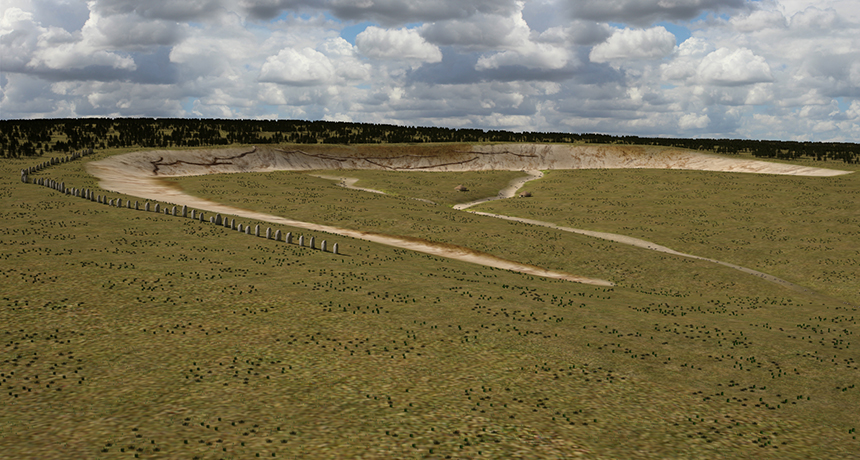Picture This: ‘Super-henge’ buried near Stonehenge
Ground-penetrating radar reveals that as many as 90 massive stones once lined the edge of an ancient village

A row of stone pillars, depicted here, once lined the boundary of a settlement near Stonehenge in southern England. Archaeologists discovered the stones, now buried, using a technology called ground-penetrating radar.
LUDWIG BOLTZMANN INSTITUTE, ARCHAEOLOGICAL PROSPECTION AND VIRTUAL ARCHAEOLOGY
By Bruce Bower
The prehistoric Stonehenge monument in southern England towers over the landscape. Now, researchers have discovered that a nearby village boasted an imposing stone monument of its own. Only its remains lay hidden underground.
As many as 90 large stones once surrounded the site, called Durrington Walls. The stones were later intentionally buried, says archaeologist Vince Gaffney. He’s an expert on Stonehenge and one of the leaders of the team that discovered the buried stones. He works for the University of Bradford in England. Gaffney announced the find September 7 at the British Science Festival in Bradford.
Durrington Walls is about three kilometers (two miles) from Stonehenge. It was built around 4,600 years ago. Today it is ringed by a wide ditch — and outside of that, a raised earthen bank. Such a ditch-and-bank earthwork is called a henge. Durrington Walls covers an area five times the size of Stonehenge. Because of its size, researchers call Durrington Walls a “super-henge.”
Gaffney and his coworkers were able to peer into the ground beneath the super-henge without ever lifting a shovel. They did it using a technology called ground-penetrating radar. It works by sending out pulses of electromagnetic radiation toward the ground. The waves of energy travel through the soil until they strike an object below. The waves then bounce off of the object and return to the surface. Scientists can use the reflected signals to build a map of whatever lies buried beneath their feet.
At Durrington Walls, the researchers discovered that a row of massive stones once stood along one border of the site. Some were up to 4.5 meters (about 15 feet) high. These stones were pushed over and covered by soil that was used to construct the earthen bank, Gaffney said. As many as 30 stones remain intact. Other stones are broken. Still others are missing. (The only evidence they existed is the massive pits where they once stood.)
Gaffney suggests the newly discovered stone row may be as old or older than Stonehenge. If true, the stones would have been set in place around 5,000 years ago.
Power Words
(for more about Power Words, click here)
archaeology The study of human history and prehistory through the excavation of sites and the analysis of artifacts and other physical remains. People who work in this field are known as archaeologists.
Durrington Walls The name of a large Neolithic settlement in southern England. The site is about 3 kilometers (two miles) from the Stonehenge monument. It covers an area about five times as large as Stonehenge.
electromagnetic radiation Energy that travels as a wave, including forms of light. Electromagnetic radiation is typically classified by its wavelength. The spectrum of electromagnetic radiation ranges from radio waves to gamma rays. It also includes microwaves and visible light.
ground-penetrating radar A method of detecting the presence, position, distance or other important characteristics of objects (such as rocks or archeological artifacts) or substances (such as water or ice) underground. It works by sending out pulses of electromagnetic radiation that travel through earth and bounce off objects below. Scientists then measure how long it takes that bounced signal to return.
henge An earthwork structure composed of a circular central area surrounded by a ditch, and outside of that, a raised earthen bank. Henges sometimes contain a circle of stones or wooden timbers. They also may contain pits or burial sites. (Stonehenge, perhaps the most famous prehistoric monument featuring a ring bank and ditch, is an exception to the usual form of a henge, in that the ditch is outside the bank.)
Stonehenge A monument made of large stones, located on Salisbury Plain in Wiltshire, England.







